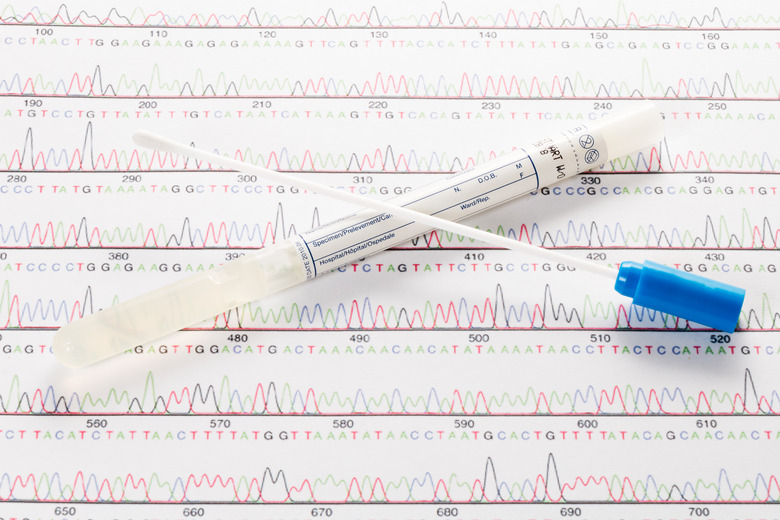The Advantages Of Using Sticky End Enzymes
Molecular cloning is a common biotechnology method that every student and researcher should be familiar with. Molecular cloning using a type of enzyme called a restriction enzyme to cut human DNA into fragments that can then be inserted into the plasmid DNA of a bacterial cell. Restriction enzymes cut double-stranded DNA in half. Depending on the restriction enzyme, the cut can result in either a sticky end or a blunt end. Sticky ends are more useful in molecular cloning because they ensure that the human DNA fragment is inserted into the plasmid in the right direction. The ligation process, or fusing of DNA fragments, requires less DNA when the DNA have sticky ends. Lastly, multiple sticky end restriction enzymes can produce the same sticky end, even though each enzyme recognizes a different restriction sequence. This increases the likelihood that your DNA region of interest can be cut out by sticky end enzymes.
Restriction Enzymes and Restriction Sites
Restriction Enzymes and Restriction Sites
Restriction enzymes are enzymes that cut recognize specific sequences on double-stranded DNA and cut the DNA in half at that sequence. The recognized sequence is called the restriction site. Restriction enzymes are called endonucleases because they cut double-stranded DNA, which is how DNA normally exists, at locations that are in between the ends of the DNA. There are more than 90 different restriction enzymes. Each recognizes a distinct restriction site. Restriction enzymes cleave their respective restriction sites 5,000 times more efficiently than other sites that they do not recognize.
The Right Orientation
The Right Orientation
Restriction enzymes come in two general classes. They either cut DNA into sticky ends or blunt ends. A sticky end has a short region of nucleotides, the building blocks of DNA, that is unpaired. This unpaired region is called an overhang. The overhang is said to be sticky because it wants to and will pair with another sticky end that has complementary overhang sequence. Sticky ends are like long-lost twins seeking to hug each other tightly once they meet. On the other hand, blunt ends are not sticky because all the nucleotides are already paired between the two strands of DNA. The advantage of sticky ends is that a fragment of human DNA can only fit into a bacterial plasmid in one direction. In contrast, if both the human DNA and bacterial plasmid have blunt ends, the human DNA can be inserted head-to-tail or tail-to-head into the plasmid.
Ligating Sticky Ends Requires Less DNA
Ligating Sticky Ends Requires Less DNA
Though DNA with stick ends have an easier time finding each other because of their "stickiness," neither sticky ends nor blunt ends can fuse together into a continuous piece of DNA. Formation of a continuous piece of DNA that is completely linked requires an enzyme called a ligase. Ligases connect the backbones of nucleotides at the sticky or blunt ends, resulting into a continuous chain of nucleotides. Because sticky ends find each other faster due to their attraction for each other, the process of ligation requires less human DNA and less plasmid DNA. The blunt ends of DNA and plasmids are less likely to find each other, and thus ligation of blunt ends requires that more DNA is put into the test tube.
Different Enzymes Can Give The Same Sticky End
Different Enzymes Can Give The Same Sticky End
Restriction sites are located throughout the genome of organisms, but are not evenly spaced. In plasmids, they can be engineered to be located right next to each other. Scientists who want to cut out a fragment of human DNA from the human genome must find restriction sites that are in front and in back of the region of the fragment. In addition to ensuring that a DNA fragment is inserted in the right direction, different sticky end enzymes can create the same sticky end even though they recognize different restriction sequences. For example, BamHI, BglII, and Sau3A have different recognition sequences but produce the same GATC sticky end. This increases the likelihood that there will be sticky end restriction sites that flank your human gene of interest.
References
- Molecular Cell Biology: DNA Cloning with Plasmid Vectors
- AddGene: Common Restriction Enzyme Sites
- Biochemistry: Restriction Enzymes
- Gene Cloning and DNA Analysis: An Introduction: Terry Brown
Cite This Article
MLA
Ph.D., David H. Nguyen,. "The Advantages Of Using Sticky End Enzymes" sciencing.com, https://www.sciencing.com/advantages-using-sticky-end-enzymes-17470/. 13 March 2018.
APA
Ph.D., David H. Nguyen,. (2018, March 13). The Advantages Of Using Sticky End Enzymes. sciencing.com. Retrieved from https://www.sciencing.com/advantages-using-sticky-end-enzymes-17470/
Chicago
Ph.D., David H. Nguyen,. The Advantages Of Using Sticky End Enzymes last modified August 30, 2022. https://www.sciencing.com/advantages-using-sticky-end-enzymes-17470/
